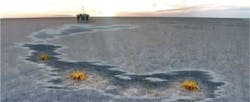Subsea production under way at Vega
Gene Kliewer • Houston
Statoil has kicked off production from the Vega gas and condensate field off Norway’s west coast. Vega has three seabed templates that send gas and condensate to the Gjøa platform. At full capacity, the Vega field will deliver 7 MMcm/d (247 MMcf/d) of gas and 3,900 cm/d (24,500 b/d) of condensate. At start-up, four wells were online. The final two are scheduled online in April.
The project was completed on time and budget at a cost of NOK 7.6 billion ($1.267 billion). The Vega field consists of two licenses, Vega and Vega Sør.
“The Vega field is what we call a technology-qualifying field. We have carried out 39 technology qualifications. This means that the equipment has been tested and designed to be used in new areas. This was done simultaneously with the development,” said Vega project coordinator Helge Hagen.
Subsea structures on the way to Vega. Photo by Andre Osmundsen/Statoil.
Vega by the numbers:
- Vega comprises 1.4% of Statoil’s total own production, and 2% of its total oil and gas production on the Norwegian shelf
- Recoverable reserves are 18 bcm (635.6 bcf) of gas and 26 MMbbl of condensate
- The Vega discoveries were made in 1982 and 1987
- The partners in Vega are Statoil (60%) and Petoro (40%)
- The partners in Vega South are Statoil (45%), Bayerngas Norge (25%), Idemitsu Petroleum Norge (15%), and GDF SUEZ E&P Norge (15%)
- FMC supplied underwater equipment and structures
- Heerema did the heavy lifts in connection with the subsea structure installation
- Subsea 7 handled the laying and connection of pipelines and cables
- Dolphin Drilling completed clean-up of wells usingBideford Dolphin.
Ormen Lange subsea systems on order
Elsewhere in the North Sea, Norske Shell has awarded a $95-million contract to FMC Technologies to supply the Ormen Lange development with subsea systems. The contract covers one eight-slot manifold, four pipeline end modules, control systems, and connection equipment.
Ormen Lange is the North Sea’s deepest subsea development at 1,000 m (3,300 ft).
Petrobras, FMC to develop technology
At one of the other major subsea development areas in the world, Petrobras has signed a memorandum of understanding with FMC Technologies Inc. to develop future subsea technology for projects offshore Brazil.
The agreement includes the development of “innovative and cost effective subsea production systems to address the challenges associated with Petrobras’ pre-salt oil and gas fields. It also includes the design of subsea processing technologies that can increase recovery rates at Petrobras’ maturing oil and gas fields,” according to FMC.
Clariant joins deepwater Brazil action
Clariant has won a contract to supply chemicals for pre-salt application from Petrobras.
The agreement covers the chemical package and services for the Petrobras FPSOCapixaba, which operates off the Espírito Santo. Production currently is based on post-salt and pre-salt reserves, with pre-salt production having started this past July.
Acergy to run Capixaba pipe
Petrobras also awarded Acergy S.A. a contract for subsea pipeline work at the Sul-Norte Capixaba project. Acergy will install an 18-in., 150-km (93-mi) igid gas pipeline to link the Camarupim field gas pipeline to the Parque das Baleias complex. Acergy’s charge includes the associated diving, construction and pre-commissioning activities.
Total contract value is approximately $240 million, of which Acergy’s share is approximately $190 million. Engineering is under way with offshore installation scheduled to commence late 2011, using theAcergy Polaris and Acergy Harrier.
Expro awarded test tree contract
Switching to the India Ocean, Expro has been awarded a subsea contract worth $4 million. State-owned Oil & Natural Gas Corp. Ltd has awarded Expro a three-year subsea test tree contract. The award includes mobilization of one set of subsea test tree equipment with accessories for 400 m (1,312 ft) of water and one firm and one optional set of subsea test tree equipment with accessories for 300 m (984 ft) water depth. Expro also will provide personnel for the operation.
Decommissioning tool designed for subsea use
Seanic Ocean Systems has developed a subsea drill to support the growing platform decommissioning and salvage market.
Seanic’s system combines technology with standard ROV interface.
“The drill is hydraulically powered and operated through the ROV’s valve pack and allows for the option to be mounted either by magnet or sticky feet (vacuum created from suction cups),” said Andy Guinn, VP of Operations. “The drill was developed to cut holes into any flat or tubular surfaces as small as a 10-in. diameter. It will accept up to a 4-in diameter annular cutter and has a stroke of over 13-in. while cutting through steel or grout.”
Seanic has delivered two of the tools to date.
Offshore Articles Archives
View Oil and Gas Articles on PennEnergy.com


